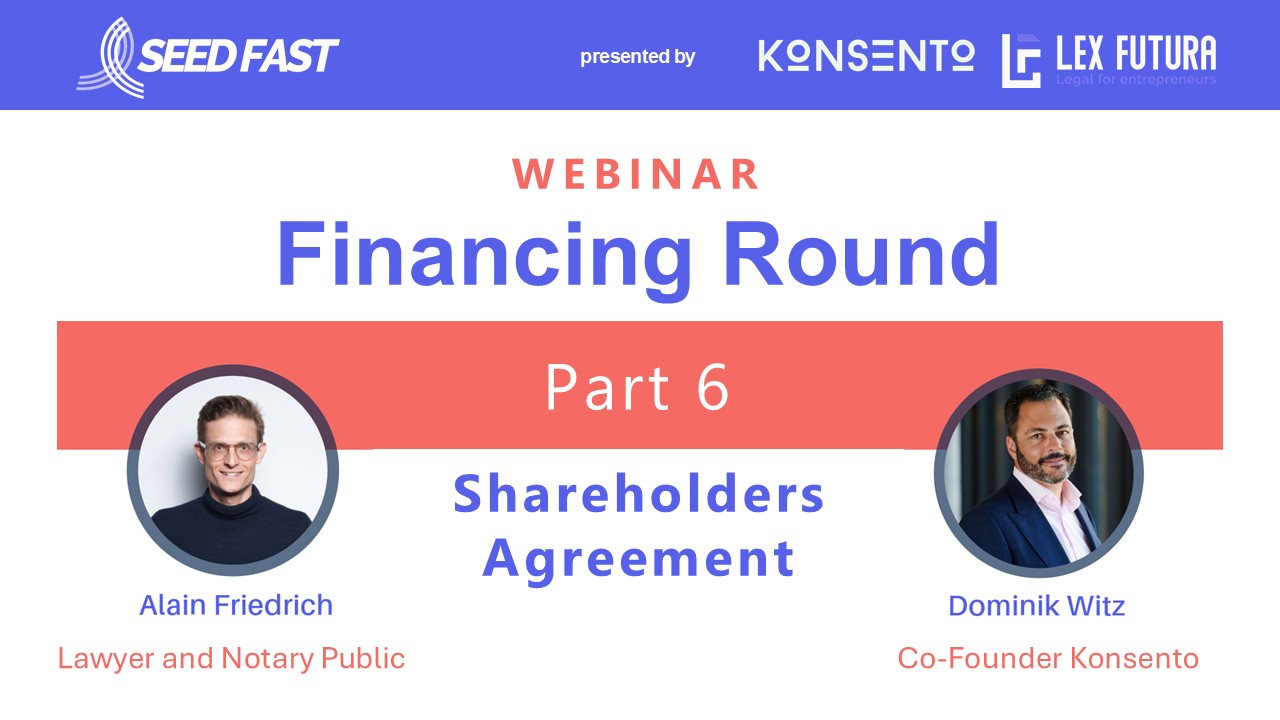During financing rounds, the Shareholders' Agreement (commonly referred to as "SHA") is a key document defining the rules of engagement between shareholders. Below is an overview of what founders need to know about the SHA and which topics are typically covered.
What is a Shareholders' Agreement?
A Shareholders' Agreement is a contractual agreement between the shareholders of a corporation that regulates their rights and obligations towards each other. The SHA complements the company’s Articles of Association, which primarily govern the relationship between the company and its shareholders.
Why is an SHA necessary? Many aspects that are crucial for both investors and founders cannot be regulated effectively or comprehensively within the Articles of Association alone. This includes, for example, non-compete clauses, vesting rules, information rights, or tag-along rights. The SHA provides binding and transparent rules in these areas.
Contents of the SHA – Key Provisions
A well-drafted Shareholders' Agreement typically contains the following core elements:
1. Ownership Structure
The agreement specifies the ownership structure after the capital increase – including the exact shareholdings of each party and their contact details. This information is often included on the cover page or as an annex.
2. Governance & Control Rights
Who will be part of the Board of Directors? Is executive management delegated? Which corporate decisions require investor approval? The SHA defines participation rights and veto powers, particularly for key decisions such as acquisitions or future funding rounds.
3. Information Rights
The statutory information rights under Swiss law are limited. The SHA can define additional reporting obligations, such as quarterly reports, rights to inspect documents, or requirements for regular shareholder meetings.
4. Vesting Provisions
Investors want to ensure that founders remain committed to the company. Vesting clauses specify when and under what conditions founders "earn" their shares. If a founder leaves early, a portion of their shares may be forfeited or repurchased.
5. Liquidation Preferences
In an exit scenario, investors often seek preferential treatment regarding their invested capital. Liquidation preference clauses define such rights, including specific terms for "down rounds" or low-valuation exits.
6. Anti-Dilution Protection
If the company's valuation decreases in later financing rounds, anti-dilution provisions protect investors from dilution by granting them additional shares to maintain their ownership percentage.
7. Pre-Emption Rights
The SHA defines the process if a shareholder does not exercise their pre-emption rights. Who gets the opportunity to purchase those shares? Existing shareholders, investors, or founders?
8. Employee Participation
The agreement can set aside a certain percentage of the share capital (typically around 10%) for employee stock option plans (ESOP), helping to attract and retain talent.
9. Transfer Restrictions
Shares are often subject to transfer restrictions. Right of first refusal, call options, or approval requirements are common mechanisms to prevent undesirable shareholders from entering the company.
10. Tag-Along / Drag-Along Rights
These provisions ensure that minority shareholders can participate in an exit or that they cannot block a sale initiated by the majority.
11. Non-Compete and Non-Solicitation Clauses
Particularly important for founders: The SHA may prohibit them from competing with the company or soliciting employees or customers – typically backed by contractual penalties.
Practical Tips for Founders
1. Understand what you are signing
Seek professional advice, educate yourself, and take the time to fully understand the terms of the SHA. It can significantly impact your future freedom as a founder.
2. One SHA only
Avoid parallel agreements as they often lead to conflicts. If individual arrangements between certain shareholders are necessary, use side letters – but ensure they align with the SHA.
3. Think about the exit from the start
Even if an exit feels far off, planning begins at entry. A well-structured SHA simplifies later transactions and can pave the way for a smooth exit process.
Interested? Then …
… watch the video!
The Shareholders' Agreement (SHA) defines the rules between founders and investors — from governance to exit. Founders should know what they’re signing!
Then click your way into our YouTube webinar: Part 6 - Shareholders‘ Agreement | SeedFast-Webinar financing round
… read the next blog post!
SHA signed? Great — but your round isn’t done yet. The final step is the Execution.
Want to know how? Then read more: Part 7 - Closing your financing round | SeedFast-Webinar financing round
… plan your financing round with us!
Thinking about raising capital?
We support you in making your round smooth, investor-ready and compliant – without the legal headaches.
Start your inquiry at www.seedfast.ch.
… and if you have questions: reach out to us!
This format is brought to you by:
- Konsento – the platform for legally secure company documents
www.konsento.ch - Lex Futura – the law firm for innovative legal support for startups
www.lexfutura.ch



